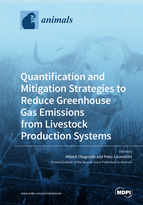Quantification and Mitigation Strategies to Reduce Greenhouse Gas Emissions from Livestock Production Systems
A special issue of Animals (ISSN 2076-2615). This special issue belongs to the section "Animal System and Management".
Deadline for manuscript submissions: closed (31 August 2019) | Viewed by 60570
Special Issue Editors
Interests: animal breeding and genetics; proxy phenotypes; genotype x environment interaction; greenhouse gas measurements from ruminant systems, predictive modelling in livestock systems
Interests: quantitative hereditary variation, improved phenotyping, animal fertility, metabolism, behavior, production and efficiency, including methane emissions, and genetic variation in metagenome
Special Issue Information
Dear Colleagues,
In recent years, the evidence of change in the global climate system has been unequivocal and climate change has become a growing international concern. It is well-established that the release of greenhouse gases (GHG) predominantly derived from human activities is a major contributing factor to most of the observed climate change. The global livestock sector, particularly ruminants, contributes approximately 18% of total anthropogenic GHG emissions (Steinfeld et al., 2006). GHG emissions arise from processes both on and off the farm and include methane (CH4), nitrous oxide (N2O) and carbon dioxide (CO2). Different initiatives are being taken to reduce GHG emissions. For example, the European Union has committed itself to reduce its GHG emissions by 20% by the year 2020 relative to 1990 levels. Different countries and group of countries have different targets. However, it is important to undertake initiatives that can reduce GHG emissions without compromising livestock productivity. Finding a balance between improving productivity and reducing GHG in livestock systems is crucial in order to maintain sustainability in the future.
Efficient agricultural practices are key to reducing greenhouse gases emissions. These practices can be achieved through several aspects of livestock production. For example, livestock genetic improvement, changes in feeding strategies, nutritional improvement, disease control and animal health improvement, improvement in animal welfare and general husbandry. However, care ought to be taken, as a focus on reducing emissions in one particular part of a system may result in an inherent increase elsewhere in the system.
Technical solutions to reduce GHG emissions have been, and continue to be, extensively researched. Globally, different research groups are investigating different components in this regard on an ongoing basis. Although some of this information has been previously reported elsewhere, new knowledge is being generated and more effective strategies are being developed.
This Special Issue seeks contributions including reviews and original research in two broad but related areas: 1) measurement techniques and protocols, use of proxies, methodological opportunities and challenges including uncertainty in quantification of GHG emissions from livestock systems; and 2) methods, techniques, and strategies for reducing GHG emissions from livestock production systems.
Prof. Dr. Mizeck Chagunda
Dr. Peter Løvendahl
Guest Editors
Manuscript Submission Information
Manuscripts should be submitted online at www.mdpi.com by registering and logging in to this website. Once you are registered, click here to go to the submission form. Manuscripts can be submitted until the deadline. All submissions that pass pre-check are peer-reviewed. Accepted papers will be published continuously in the journal (as soon as accepted) and will be listed together on the special issue website. Research articles, review articles as well as short communications are invited. For planned papers, a title and short abstract (about 100 words) can be sent to the Editorial Office for announcement on this website.
Submitted manuscripts should not have been published previously, nor be under consideration for publication elsewhere (except conference proceedings papers). All manuscripts are thoroughly refereed through a single-blind peer-review process. A guide for authors and other relevant information for submission of manuscripts is available on the Instructions for Authors page. Animals is an international peer-reviewed open access semimonthly journal published by MDPI.
Please visit the Instructions for Authors page before submitting a manuscript. The Article Processing Charge (APC) for publication in this open access journal is 2400 CHF (Swiss Francs). Submitted papers should be well formatted and use good English. Authors may use MDPI's English editing service prior to publication or during author revisions.
Keywords
- Greenhouse gas emissions
- climate change
- reduction strategies
- livestock
- productivity
- sustainability







